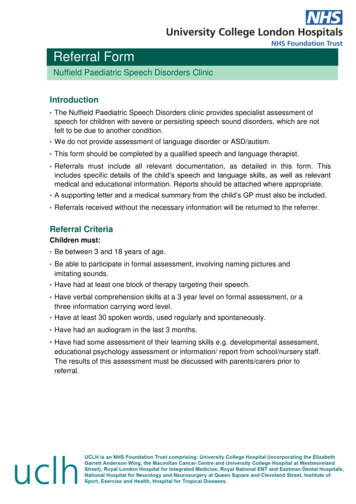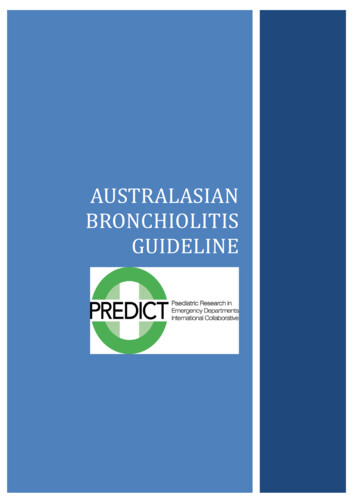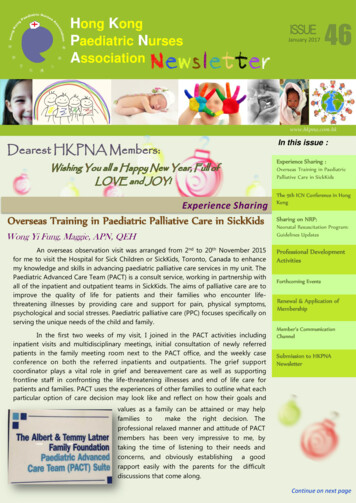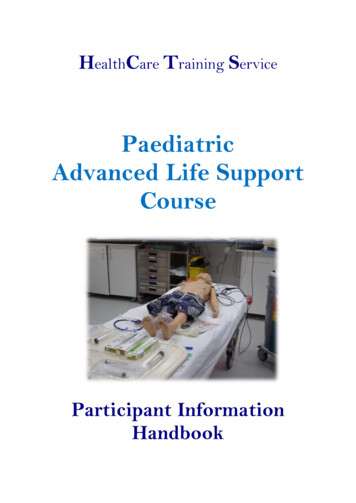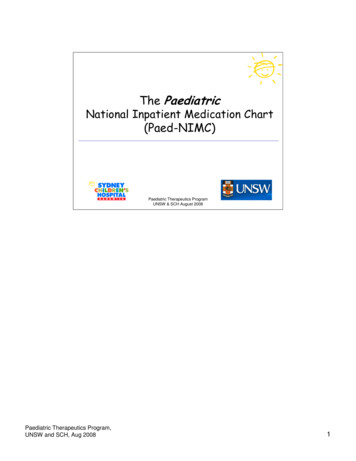
Transcription
The PaediatricNational Inpatient Medication Chart(Paed-NIMC)Paediatric Therapeutics ProgramUNSW & SCH August 2008Paediatric Therapeutics Program,UNSW and SCH, Aug 200811
Background“To reduce the harm to patients frommedication errors, by June 2006, all publichospitals will be using a common medicationchart. This means that the same chart will beused wherever a doctor or nurse works andwherever the patient is within a hospital.”Australian Health Ministers’ Conference, 23 April 2004Paediatric Therapeutics ProgramUNSW & SCH August 20082 To improve the safety and quality of medicines use nationally, the Australian HealthMinisters Advisory Council (AHMAC) decided that all public hospitals in Australiawould be using a common medication chart. The National Inpatient Medication Chart(NIMC) was developed by a multi-disciplinary national working party. Similarly, anationally agreed paediatric version (paed-NIMC) has been developed, sharing manyfeatures with the original NIMC, but incorporating additional features important forfacilitating safe medicines use in the paediatric population.Paediatric Therapeutics Program,UNSW and SCH, Aug 20082
Background Medication errors in hospitalised children occur atsimilar rates to adults (4.3-5.7% of orders)- but have 3 times the potential to cause harm- prescribing errors commonest about 80% of errors associated with harm Many medication errors and adverse drug eventsare preventableLevine SR et al, J Paediatr Pharmacol Ther 2001;6:426-42Fortescue EB et al, Paediatrics 2003;111:722-729Paediatric Therapeutics ProgramUNSW & SCH August 2008Paediatric Therapeutics Program,UNSW and SCH, Aug 200833
Children are more vulnerable immature organ function to metabolise drugs mg/kg doses require calculations small doses required - a small change maymake a big difference clinically dosage forms are usually in adult sizes liquid formulations need to be measuredand/or dilutedPaediatric Therapeutics ProgramUNSW & SCH August 2008Paediatric Therapeutics Program,UNSW and SCH, Aug 200844
Paediatric Therapeutics Program,UNSW and SCH, Aug 20085
The 4R’s Right drug right indication right dose right form right route Right child Right time Right outcomePaediatric Therapeutics ProgramUNSW & SCH August 2008EFFICACYSAFETY6* Whenever we’re using medicines, a common aim for all of us is to make sure that weget the 4R’s right* The right drug, being given for the right reason and in the right dose, form and routeto the right child at the right time to achieve the right outcome* We need to get the 4R’s right all the time in order to maximise the benefit andminimise the risks associated with any medication usePaediatric Therapeutics Program,UNSW and SCH, Aug 20086
THE MEDICATION USE ONITORINGPaediatric Therapeutics ProgramUNSW & SCH August 20087 In order to achieve this goal, a number of steps have to be carried out correctly:these include prescribing, dispensing, administering and monitoring the use and effectof medicines. This diagram is a very simplified representation of what is actually a much morecomplex system, involving many steps and many people, interacting with each other The ideal is that all of this functions correctly all of the time This needs GOOD COMMUNICATION between the different peopleinvolved in the medication use system. The NIMC and associatedguidelines for use are intended to facilitate better communication.Paediatric Therapeutics Program,UNSW and SCH, Aug 20087
Safe Prescribing Guidelines Write LEGIBLY and PRINT prescription instructionsno matter how accurate, if it can’t be read, it can be misinterpreted Check DOSE prescribed (Dr, pharmacist, RN) Use only ACCEPTED ABBREVIATIONS Use GENERIC NAMES of medicines– Don’t abbreviate drug names CEASE and REWRITE ORDERSwhen any changes are made, especially to dose or frequency See full Safe Prescribing Guidelines in Paed-NIMC EducationalResources ediatric Therapeutics ProgramUNSW & SCH August 2008Paediatric Therapeutics Program,UNSW and SCH, Aug 200888
Improving Medication Safety in ChildrenGuideline adherencePresc name100% charts90Weight80Allergy/ADR box7060Ceasing correctly50Pager noted4030201002003200420052006Gazarian M, Graudins LV, Ginsborg L et al March 2007Paediatric Therapeutics ProgramUNSW & SCH August 20089Some data from SCH about selected safe prescribing elements Paediatric Therapeutics Program,UNSW and SCH, Aug 20089
The Paediatric National InpatientMedication Chart (Paed-NIMC) NIMC supports safe prescribing principles to– improve communication about medication orders– ensure that the right drug, in the right dose is given tothe right patient at the right time.– minimise harm to patients from preventablemedication errors NIMC is to be used for all inpatients whocurrently use a general medication chart NIMC does not replace specialised chartse.g. Chemotherapy, insulin, IV FluidPaediatric Therapeutics ProgramUNSW & SCH August 2008Paediatric Therapeutics Program,UNSW and SCH, Aug 20081010
Paed-NIMCShort stayInsideopened A3Paediatric Therapeutics ProgramUNSW & SCH August 2008Paediatric Therapeutics Program,UNSW and SCH, Aug 20081111
Paed-NIMClong-stayPaediatric Therapeutics ProgramUNSW & SCH August 2008Paediatric Therapeutics Program,UNSW and SCH, Aug 20081212
NIMCPaedbackfrontPaediatric Therapeutics ProgramUNSW & SCH August 2008Paediatric Therapeutics Program,UNSW and SCH, Aug 20081313
Patient Identification“wrong patient” errors occur when ID not visible affix patient ID label or write information on front and back of chartAND on all yellow copies if using labels: first prescriber must print patient name on front and back. write in (ideal) WEIGHTPaediatricon all charts& height,BSA if requiredTherapeuticsProgram14UNSW & SCH August 2008Paediatric Therapeutics Program,UNSW and SCH, Aug 200814
Adverse Drug Reactions:Accurate information prevents harm fromknown ADRs TICK BOX if patient has nilknown allergies or unknownallergies status; sign, print, dateentry IF VERIFIED ADR write: drug name type of reaction date of reaction; who recorded the information prescriber has primaryresponsibility, but may beRN or pharmacist See SCH ADR Working Partyrecommendations 2007 lGPaediatric Therapeutics ProgramUNSW & SCH August 2008lG1/11/200815 Recording Adverse Drug Reaction information is an important part of drug therapy. Omission of ADR information permits the opportunity to re-prescribe and administerthe same or similar agent No medication should be dispensed or administered from a chart until this section iscompletePaediatric Therapeutics Program,UNSW and SCH, Aug 200815
Chart Numberingaim to keep chart numbers to a minimum toreduce risk of duplication and omissionadditional chartsPaediatric Therapeutics ProgramUNSW & SCH August 200816Chart numbering is a simple method of accounting for all charts currently in use for apatient. This information will need to be updated as additional charts are written orcharts are ceased. When more than one chart is in use, number can help ensure thatmedication orders are not inadvertently overlookedPaediatric Therapeutics Program,UNSW and SCH, Aug 200816
Medications on admission:important for medication reconciliation Better access to admission medication history Compare therapy on admission with that at dischargeImportant for Medication Reconciliation Can be added to by Dr, RN or pharmacistPaediatric Therapeutics ProgramUNSW & SCH August 200817 The admitting medical officer, a pharmacist or other clinician trained in medicationhistory documentation may complete this section. The following information is needed:- a complete list of all medicines taken normally at home (prescription and nonprescription, eg complementary meds) including drug identification details(generic name, strength and form), dose and frequency, and duration oftherapy/when therapy started- whether the patient has their own medicines with them- whether there is a preferred dose form (eg suspension or tablet)- contact details for patient’s GP and Community Pharmacist Differences between medications taken prior to admission and currently prescribedmedications should be explained in the medical notes or otherwise queried withattending medical staff.Paediatric Therapeutics Program,UNSW and SCH, Aug 200817
date (of the initial order) PRINT the genericname of medicine DOSE-check by RNand pharmacist Frequency, route –Regular medicationsacceptedabbreviations only Indicationespecially when drughas different dose fordifferent use eg cotrimoxazole for PCPprophylaxis or UTI, orwhen ID approvalneeded for antibiotic prescriber signature,print name & pager orcontact number.Paediatric Therapeutics ProgramUNSW & SCH August 200818 The way in which the regular medication section is to be completed represents somechange in practice Legal requirements for a valid prescription still stand. These include, the date theprescription is to be started, the medication name, strength, route of administrationand the frequency of administration. The script must be signed by the prescribingdoctor. To ensure queries about prescriptions can be solved, prescribers are alsoasked to print their names and contact details (e.g. pager number). In addition to these requirements the chart has space for the indication for themedication, the basis for the dose calculation and instructs the prescribing doctorto enter the administration times. These features represent a significant change inpractice. Many errors involve the administration of the wrong medication. A large number ofthese errors occur because of poor legibility of the order, misinterpretation ormisreading of the order or because of drug names which look-alike or sound-alike (egazathioprine vs azithromycin). By entering the indication for each medication, ordersbecome more clear, and errors decrease. Entering the indication also helps to preventinadvertent cessation of therapy, by differentiating between medications used foracute problems, and those which are used for chronic conditions.Paediatric Therapeutics Program,UNSW and SCH, Aug 200818
Basis for dose calculation Document the basis for the dose calculationeg mg/kg or mg/m2 per doseCheck dose in current paediatric dosing reference endorsed by the local DTC.eg RCH Pharmacopoeia or local DTC endorsed paediatric reference Calculate dose using accurate weight or BSA up to usual adult dose use calculator RNs to double-sign indicating dose checked and administered Recording the dose here helps double-checking by pharmacists, nurses andother doctors, ensuring that both the intended mg/kg or per m2 and actual dose19calculated are correct. Paediatric Therapeutics Program UNSW & SCH August 2008 The availability of a designated space to document the basis for the dosecalculation is one of the major differences between the paediatric and adultversion of the NIMC. This feature is also likely to be one of the most important NEW featuresof the chart that will help reduce dosing errors (which are the mostcommon medication errors in paediatrics) and associated harmPaediatric Therapeutics Program,UNSW and SCH, Aug 200819
AbbreviationsNSWTAG: ons/guidelines/TERMINOLOGY1206.pdfDON’T use theseerror-proneabbreviationsoWrite this insteadug mcgmicrogramITintrathecaloddailyU or uunit‘Oral’ or ‘poPaediatric Therapeutics ProgramUNSW & SCH August 200820 See NSW TAG guidelines for full set of recommended abbreviations to useand dangerous abbreviations that must not be usedPaediatric Therapeutics Program,UNSW and SCH, Aug 200820
Administration timesFor regularmedications theadministrationtimes are to beentered by theprescriber For young childrenwho have variable mealand sleep schedules, theprescriber should ideallydiscuss with thepatient’s parent/carerand nurse to determinean appropriate schedule See box on chart forguidancePaediatric Therapeutics Program21UNSW & SCH August 2008 The prescribed dose frequency may not correspond to the entered administrationtimes. This error arises when frequencies are interpreted by another clinician. Byrequesting that the prescribing doctor enter the administration times, this potential forerror is removed, and has been shown in pilot studies elsewhere to reduce frequencyand administration time mismatch. Further advice is available to address specific paediatric scenarios involvingadministration times (see FAQs section at paed-NIMC website)Paediatric Therapeutics Program,UNSW and SCH, Aug 200821
Frequency:guide only-MO to discuss with RN and carersPaediatric Therapeutics ProgramUNSW & SCH August 200822To assist with entering administration times, a table of suggested administration timesfor common dose intervals is included on the chart.Paediatric Therapeutics Program,UNSW and SCH, Aug 200822
Additional informationLG Additional information & pharmacist notes to clarify order,eg specific formulation, dilution, storage, monitoringPharmacists will initialthis sectionasPrograma record that they havePaediatricTherapeuticsUNSW& SCHonAugustreviewed the medicationchartthat2008day23 Clinical pharmacists and prescribers can write additional information on an order in thepharmacy/additional info box. The clinical pharmacist will sign the pharmaceutical review section as a record thatthey have reviewed the entire medication chart (on that day) to ensure that all orders areclear, safe and appropriate for that individual patient, therefore the risk of an adversedrug event is minimised.Paediatric Therapeutics Program,UNSW and SCH, Aug 200823
‘PRN’ medicines Basis for dose calculation and indicationPrescriber must include dose or dose range (eg 5-10mg) and hourly frequency (eg 4-6hrly).The pre-printed 'PRN' is not sufficientmaximum daily dose (i.e. in a 24 hour period). This may differ by indication:e.g. paracetamol prescribed for pain may be given to a maximum daily dose of90 mg/kg, but limited to 60 mg/kg when prescribed for symptomatic feverThe person administering each dose is responsible for checking that thePaediatric Therapeutics Program24maximum daily dose will notbe&exceeded.UNSWSCH August 2008Paediatric Therapeutics Program,UNSW and SCH, Aug 200824
Ceased Orders8 hourly To change the dose or frequency, cease & rechartSingle line through original order; ANDA clear line through the administration record section with––date and initial; andreason for ceasingPaediatric Therapeutics ProgramUNSW & SCH August 2008Paediatric Therapeutics Program,UNSW and SCH, Aug 20082525
Frequent Medications6x medsGiven greater than 6 times a day but not “PRN”eg. eye drops, inhaled medication Bracket 2 regular medication order spaces and use bothadministration sections for administration documentation.Second space should be crossed outPaediatric Therapeutics ProgramUNSW & SCH August 2008Paediatric Therapeutics Program,UNSW and SCH, Aug 20082626
Limited duration orders100mg8 hourlyPaediatric Therapeutics ProgramUNSW & SCH August 200827When a medicine is ordered for a limited duration, or only on certain days, this mustbe clearly indicated using crosses (X) to block out day/times when the drug is NOT tobe given.This principle also applies for ONCE weekly medications, eg low dose Methotrexatefor juvenile idiopathic arthritis.Paediatric Therapeutics Program,UNSW and SCH, Aug 200827
AdministrationRN to enter on administrationside if the dose not given- circle code to ensure won’tbe misread as RN initialsPaediatric Therapeutics ProgramUNSW & SCH August 200828When it is not possible to administer the prescribed medicine, the reason for notadministering must be recorded by entering the appropriate code and circling. Bycircling the code it will not accidentally be misread as someone’s initials.If a patient refuses medicine(s), then the medical officer must be notified.If medicine(s) are withheld, the reason must be documented in the patient’s medicalnotes.If the medicine is not available on the ward, it is the nurse’s responsibility to notify thepharmacy and/or obtain supply or to contact the medical officer to advise that themedicine ordered is not available.Paediatric Therapeutics Program,UNSW and SCH, Aug 200828
Once only, pre-medication,nurse initiated medicinesseparate from regular medicines to reduce risk of continued administration Once only, pre-medication and nurse initiated medicines are separate from regularmedication to reduce the risk of continued administration Space for entering both actual dose and basis for dose calculation (eg mg/kg/dose) Use box with diagonal line for double-checking and signing by 2 RNsPaediatricTherapeuticsProgram Follow local policy for determiningnurseinitiated medicines29UNSW & SCH August 2008Paediatric Therapeutics Program,UNSW and SCH, Aug 200829
Telephone orders? verbal and telephone orders ONLY in emergencies(except eg Insulin)must be confirmed by 2nd nurse as an independent double-check- read back to prescriber- double-check accuracy of dose orderedmust be countersigned by prescribing doctor within 24 hoursX Cytotoxic, SchedulePaediatric8 andTherapeuticsregular medicationorders are NOT toProgram30be prescribed per phoneUNSW & SCH August 2008[Some facilities or specialties (eg paediatric hospitals, chemotherapy) may notallow telephone orders at all, check local policy first] Verbal or telephone orders from prescribers that are onsite in the hospital shouldonly be used in emergencies or during sterile procedures where ungloving would beimpractical If local policy allows it, the following must be documented for telephone orders:-date prescribed-generic name of medicine-route of administration-dose to be administered-date and time medicine is to be administered-name of doctor giving verbal order-initials of two nursing officers to confirm that verbal order heard andchecked[NB checking is considered to be appropriate when verbal or phone ordersmust be taken, the nurse or pharmacist receiving the order immediately writesit down and reads it back to the prescriber for verification and, where possible,there is a system of independent double checking]-time of administration The telephone order MUST be signed, or otherwise confirmed in writing, within24 hoursPaediatric Therapeutics Program,UNSW and SCH, Aug 200830
NIMC Paeds vs adultsClinicians providing both adult and paediatric servicesshould familiarise themselves with differences between thepaediatric and adult versions of the NIMC.The Paediatric chart has 1.2.3.4.No designated warfarin or variable dose medicines sectionsDesignated space for recording weight, height and BSADesignated space for documenting basis for dosecalculation (eg mg/kg/dose)Need for double signing when recording administration, todocument double checkingPaediatric Therapeutics ProgramUNSW & SCH August 2008Paediatric Therapeutics Program,UNSW and SCH, Aug 20083131
Prescribing practiceAmber StoneMRN: 1234567Weight: 20kg Height:150cmBSA:0.9m2DOB: 02/02/2000 Oncology patient with febrile neutropaenia and mildmoderate pain from mucositis being admitted through ED at 5 am allergic to AmoxylPrescribe:––––GentamicinParacetamol (prn for symptomatic fever)PainStop (prn for pain)Cotrimoxazole (for PCP prophylaxis)Paediatric Therapeutics ProgramUNSW & SCH August 200832This example is specific to SCH guidelines about the use of theindividual medicines in the example, which may be different in otherhospitals. The general principles illustrated should, however, berelevant to other settings. Different examples may also be used tobetter suit the needs of local circumstances.Paediatric Therapeutics Program,UNSW and SCH, Aug 200832
Paediatric Therapeutics ProgramUNSW & SCH August 200833Points to highlight: if use pt ID label, then need label on all yellow copies (if using NCR chart, eg at SCH) 1st prescriber also prints name of patient below label and checks label correct can also just write in pt ID details in main box (then don’t need to print again below ID box) Write in accurate weight ( /- ht, BSA) at same time as completing pt IDPaediatric Therapeutics Program,UNSW and SCH, Aug 200833
Paediatric Therapeutics ProgramUNSW & SCH August 200834 Emphasise points as per slide 14 in main presentation Note, especially the recording of the actual type of ADR (eg allergic rash) and date of initialreaction (2005) and who diagnosed it (eg GP). See SCH ADR definitions table for more examples of specific reaction types Ideally, verified ADR information should be recorded here. However, if there is only“suspicion” of an ADR, that could also be indicated here (eg with question mark) and in themedical records. This would alert future prescribers to check whether it is a true ADR beforedeciding if this information should impact on future prescribing decisionsPaediatric Therapeutics Program,UNSW and SCH, Aug 200834
Paediatric Therapeutics ProgramUNSW & SCH August 200835Points to highlight: Check dose in current paed dosing reference: in this instance, there is a sticker in SCH copies of RCH pharmacopoeia (red book) referring tomore up to date SCH guidelines for gentamicin (2006). Reference to SCH guidelines shows that foroncology pts the gentamicin dose is the traditional 2.5 mg/kg/dose given TDS rather than the oncedaily dosing regimen other pts may be on. There are a number of other patient groups for whom traditional gentamicin dosing isrecommended hence highlighting the need to make sure that the dose prescribed matches theindication for the prescription. Document basis for dose calculation so others can double-check accuracy Calculate dose using accurate weight use calculator The recommended administration times for 8 hrly meds are 0600, 1400, 2200. This patient was admittedand had IV inserted at 0500, so the first dose can be given right away. This can be given as a stat dose at0500 (and recorded in the stat section on the front of chart see next slide) and indicated accordingly on theregular order next to the 0600 box (see slide). Alternatively, the 1st dose being given an hour early at 0500 canbe recorded on the regular administration section (eg by writing “1st dose given at 0500”). However, there islimited available room, so care should be taken that this is done with clarity and not cause confusion aboutany of the subsequent dose administration records. the 2nd dose of gentamicin can then be given at the usual time of 1400. In most instances the 1 hourdifference (i.e. 9 hrs vs 8 hrs from the 1st to 2nd dose) will not be clinically important. However, this may vary depending on the patient's condition, the properties of the drug involvedand the dosing interval and so is a clinical decision that needs to be discussed with the prescriber ifthere is any doubt about the suitability of adhering to standard times. PS: further scenarios re administration times issues are available see FAQ section Drug levels: the SCH guidelines recommend for pts on TDS regimen 1st level should routinely be done afterthe 3rd-5th dose and then every 3-5 days. The prescriber has boxed the 5th dose to indicate timing of 1st level.Once this trough level is taken, the dose can be given at the allotted time i.e. 1400 (rather than delaying untilresult of drug level is available), UNLESS there are clinical reasons to suspect toxicity or unless the prescriberhas specifically requested that the level should be checked before 1400 dose given. In this example, the gentalevel taken at 1400 should be available by later in the day and definitely be checked before the 2200 dose isgiven Note different timing of levels for patients on once daily gentamicin (see SCH guidelines)Paediatric Therapeutics Program,UNSW and SCH, Aug 200835
Paediatric Therapeutics ProgramUNSW & SCH August 2008Paediatric Therapeutics Program,UNSW and SCH, Aug 20083636
Paediatric Therapeutics ProgramUNSW & SCH August 200837Co-trimoxazole example: indication is PCP prophylaxis dose accordingly (vs different dose eg for UTI prophylaxis orUTI treatment) write basis for dose calculation so others can double-check. Co-trimoxazole is a combinationproduct where the dose is usually calculated based on the trimethoprim component dose frequency is 3 days per week. This should be indicated by specifying actual days of the week (eg Mon, Wed, Fri) in the order section crossing out the days drug NOT to be administered in the administration section Take care to write clearly and LEGIBLY as the regular orders section can become quite“busy” once a few orders have been writtenPaediatric Therapeutics Program,UNSW and SCH, Aug 200837
zPaediatric Therapeutics ProgramUNSW & SCH August 200838 PRN section separate to REGULAR meds section Need to ensure maximum daily dose is recorded and matches the indication (eg forparacetamol maximum daily dose is 60mg/kg/day for Rx of symptomatic high fever. In theabsence of fever, maximum daily dose for treating pain is up to 90 mg/kg/day) Need to take special care with medicines such as paracetamol which might be commonlyprescribed in either or both regular and PRN sections check both sections to ensure thatthere is no double dosing and that maximum daily dose is not exceeded whenadministering . includes being aware of combination product names (eg Painstop) which containparacetamol. note also “Perfalgan” is the trade name of IV paracetamol and may be ordered forshort term pain treatment in some patientsPaediatric Therapeutics Program,UNSW and SCH, Aug 200838
Improving Medication Safety in ChildrenGuideline adherencePresc name100% charts90?8070605040WeightAllergy/ADR boxCeasing correctlyPager noted302010020032004200520062007Gazarian M, Graudins LV, Ginsborg L et al March 2007Paediatric Therapeutics ProgramUNSW & SCH August 200839Future chart audits will help us to see how well we are adhering to safe prescribing guidelineswhen using the paed-NIMCThe parameters shown here are a selection of the things we will be collecting data on in future. Recording of weight and ADR information should hopefully be near 100% soon Documentation of the basis for dose calculation (and actual dose calculated beingcorrect) will be especially interesting to followPaediatric Therapeutics Program,UNSW and SCH, Aug 200839
Paed-NIMC Round Up Paed-NIMC should support safe prescribing andadministering of medicines to children, leading toimprovements in medication safety The standardisation of charts and the special featuresincorporated should help reduce medication errors andrelated harm in hospitalised children More information available on the paed-NIMC websiteTBAPaediatric Therapeutics ProgramUNSW & SCH August 200840 The full set of resources to support education about and implementation ofthe paed-NIMC are available at TBA There are currently some unresolved issues re paed-NIMC and no doubtadditional issues will come to light as implementation proceeds, so flexibility,patience and professionalism by all involved will be needed to facilitate asmooth transition. It is important to keep in mind that OVERALL, the standardisation of chartsand the special features incorporated are POSITIVE features which shouldhelp reduce medication errors and related harm in hospitalised childrenPaediatric Therapeutics Program,UNSW and SCH, Aug 200840
Basis for dose calculation Document the basis for the dose calculation eg mg/kg or mg/m 2 per dose Check dose in current paediatric dosing reference endorsed by the local DTC. eg RCH Pharmacopoeia or local DTC endorsed paediatric reference Calculate dose using accurate weight or BSA up to usual adult dose use calculator
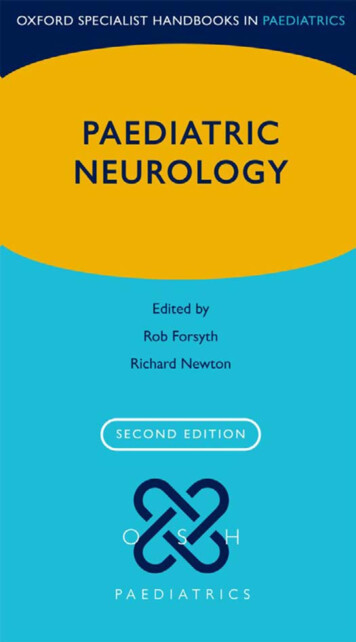


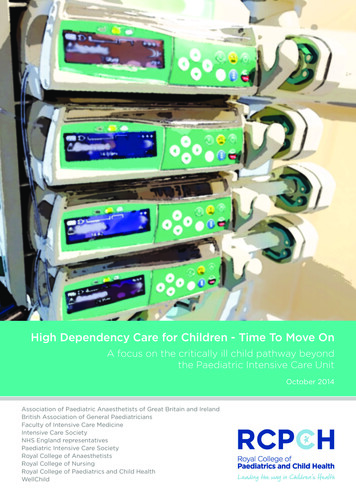
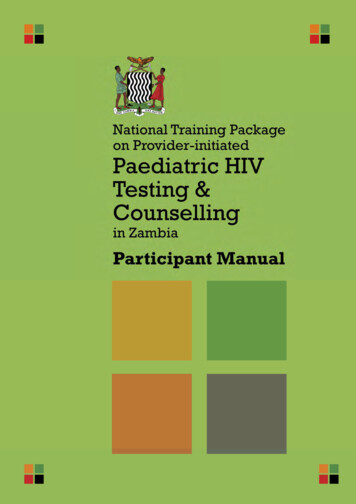
![Medical Training Initiative Post [Paediatric Neurology]](/img/35/cardiff-paediatric-neurology-mti-job-description-for-march-2020.jpg)
